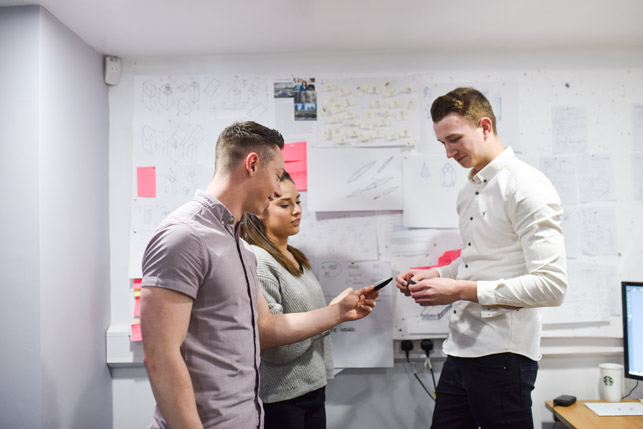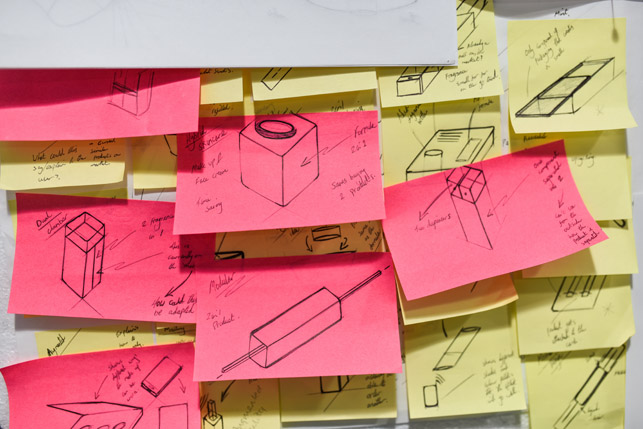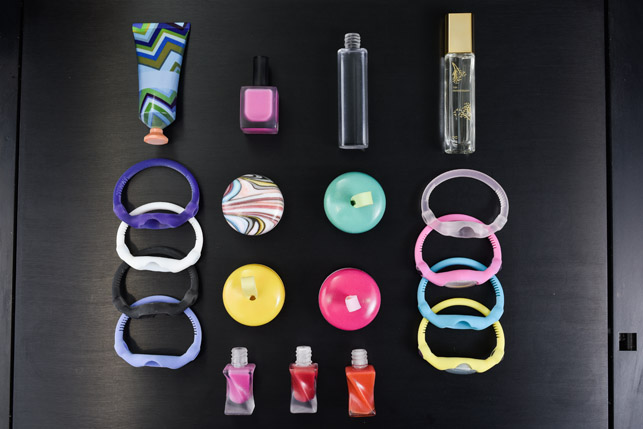Quadpack produces product packaging for brands around the world – from fragrance bottles to lipstick cases. Stephen Holmes finds out how it uses colour 3D printing to help it design for one of the most demanding, fast-paced industries: Beauty
From the polished shelves and high-end cosmetics counters of our favourite department stores to our own bathroom cabinets and dressing tables, the design of beauty product packaging is intended to inspire and delight, enticing us to buy into a lifestyle of self-care and even indulgence.
The shapes, colours, materials, dispensing methods and feel in the hand of this packaging all matter – and Quadpack Industries is a master in this field. Founded in 2003, the company is a global manufacturer of enhanced packaging solutions for beauty brand owners and contract fillers, with offices and manufacturing divisions across the world and a global turnover of around €105 million annually.
Thanks to the incredible marketing power behind perfume campaigns and skincare regimes, it’s likely you’d recognise Quadpack’s work – be it in the form of Burberry perfume bottles clutched by supermodels in TV adverts, or lavish images of Rituals and Elemis products plastered across the pages of glossy magazines.
Quadpack plays an important role in fuelling rising demand for personal grooming products, where big names are expanding into brand-new markets and raising consumer expectations of what packaging needs to be.
Never before has the demand for brand differentiation and innovation in product packaging reached such heights or scales.

Two routes for projects
Quadpack serves well over 300 clients globally, each with their own demands, branding, colour charts and materials preferences – and projects typically take one of two routes when they come through its doors.
At the high end, the client wants something unique in every sense for a new perfume, crème, gel or powder. Here, Quadpack’s young design team in the UK and in Barcelona will work with that brand from concept to production, via its bespoke service. This is based on creating a turnkey solution, through Quadpack’s existing manufacturing sites and relationships with suppliers.
The bespoke offering grew from a service the company initially developed to show clients high-quality renders of proposed packaging solutions in 3D prior to full prototyping. Since then, demand for unique product packaging has grown significantly.
The process leverages the expertise of the company’s entire team, from its market specialists in different countries, through to product designers and quality assurance staff, to expert tooling designers in its factories.
The second route to market is via Q-Line, Quadpack’s own product range. This is an exclusive collection of fully customisable packaging options, which can be enhanced with a range of elaborate decoration and finishing services selected by the client.
Q-Line items have the benefit of offering short lead times, no mould investment, and low minimum order quantities. At the same time, they offer a premium canvas to be tailored into something unique to a particular product.
The company can offer surprising textures, aluminium sheaths, even wooden caps and trays (produced by Quadpack Wood, Quadpack’s own specialist machining company in Spain), along with a host of decoration techniques, to build a full collection of cosmetic packaging products with the needs and aspirations of targeted consumer groups in mind.
“At Quadpack, we put design and innovation at the forefront of all our activities,” says Jeremy Garrard, the company’s director of design and advanced technologies, and the man responsible for design and production as far afield as China, Korea, Australia and Spain.
Quadpack – macro trend exploration

At the company’s UK base in Leek, Staffordshire, a three-person design team begins its process with a heavy dose of ‘macro trend’ exploration.
It’s strikingly similar to an automotive designer’s process, involving the compilation of ‘look books’ of colours, materials and shapes inspired by visits to design events and fashion shows and close attention to emerging, ‘zeitgeisty’ trends in specific regions.
These are then geared towards the beauty market, and concept themes are produced.
“We use external agencies to collect information, like [market research agency] Mintel and people like that, but we very much take it and create our own [style guide]. So, we have our own annual trend directive, which guides on the four themes in which we believe. It’s not just plugand-play from Mintel – it has to be very specific for our industry,” says Garrard.
The UK design team works closely with three counterparts at the company’s Barcelona head office, with personnel occasionally switching between sites, communicating via Skype, and with CAD models regularly sent back and forth for collaboration.
These designs quickly move from initial concept sketches and into 3D using Solidworks. Using a solid modelling tool might seem unorthodox for products that on first glance seem to be about block shapes and organic forms, but the process heavily leans on mechanical design.
Solidworks enables Quadpack to accurately measure the liquid contents of a vessel, while leaving enough space for a mechanism or insert, and all without wasting any excess packaging.
“We also use it for the screw threads as well, or if we have a feature that clicks or snaps together,” explains Quadpack senior designer Ollie Drew. “It’s more engineering-based, but it’s good for what we need. It’s not just about ‘the block.’”
But, as Garrard points out, while a piece of packaging of course needs to look good to sell and enhance the product inside, “personalisation for how it will look for that brand is not part of our early thinking.” At this stage, he says, it’s about the functionality, the added value, what it will do, and so on.
“And we have to keep in mind that we can’t design something that has fifty parts and is going to cost €50 to produce. It’s got to deliver what you want it to do, with a limited number of parts, at a reasonable price.”
Quadpack – moving into physical forms
Drew holds up a true 1:1 scale model of a new pen applicator. “It’s good to visualise on a screen how everything will function together,” he says, “but then, when it’s on screen, you can’t quite make out the scale of the design.”
Keyshot is used as the Company’s main visualisation software, and for all of its customer-facing renderings and animations. It brings a photorealism to the 3D models: glints and refractions in glass bottles; realistic wood grain on bottle tops; different sheens to glossy plastics and foils.
While Photoview 360 is also relied on during the design process to render Solidworks models quickly on screen, digital models often can’t convey what the physical can, says Drew.
“It’s been quite an eye-opener to see where before, we were supplying just renders, how much the customers weren’t quite understanding about what we were trying to get across,” he admits.
“Being able to show something that they’re able to touch has made such a big difference, because then they come back with questions. It helps build a relationship with the customer, that they can trust us to modify this and that we can have another model with them in a day or two.”
Quadpack initially uncovered this capability with a Stratasys Objet30 3D printer, allowing it to physically produce ideas for new caps for existing bottles, new bottle shapes for existing caps, and even new mechanisms and applicators that can be trialled for new serums and sprays.
The company is taking this work further, with a significant investment in its onsite model-making facility.
Leading off the small design studio, behind two large glass doors, sits its latest addition – a Stratasys J750, full colour, multi-material 3D printer.
In living colour
Where the Objet30 is able to produce parts in grey, blue, black and clear Polyjet materials, the J750 has massively expanded on what is possible.
Prints can be in full colour, parts can be made to feel like hard, polished production plastics, or soft-touch over moulded rubber. Quadpack can even do a fine job now of mimicking wood, leather or woven wicker textures and patinas. A recent update from Stratasys also allows for coloured transparent materials – perfect for impersonating coloured glass.
“Now, we can print a transparent colour, do a final polish and that will be the end,” say Drew.
“Whereas before you’d have to do polishing, priming, painting and then try to get it to be a translucent colour, which was difficult.”
The sizeable investment made in the 3D printer has cut post-processing time by days, freeing up the small design team to do more design and less manual labour in the model shop.
“We still have to do some,” acknowledges Drew, “but it’s nothing when compared to what it was.”
The size of the machine also makes a huge difference: its 490 x 390 x 200mm build area is capable of fitting in multiple builds or printing large assemblies in one go.
The colour element is very important in the process, whether to match a brand’s colouring for a sample design, or in order to offer an example of a concept design in a range of on-trend colourways.
Working from colours on screen to those in physical matter has not always been easy. Early colour 3D printers were often well off the mark, and it has taken time for the team at Quadpack to get even its J750 to produce the precise colours it specifies.
But thanks to its relationship with its local 3D printing technologies reseller Tri-Tech 3D (and, in turn,Tri-Tech 3D’s close ties to Stratasys), Quadpack has developed its own colour chart to help translate from Pantone to RGB values – and from that, it can reliably produce the accurate colour that the customer demands.
“With the printer, you have seven materials, and you have your CMYK in there for full colour, and you’ve got to mix each one of those to try and find your colour, which on the printer’s onboard system is quite hard to find. But then when you change the Pantone to the RGB value, you can then type in that exact code and find the colour,” says Drew.
Colour is an aspect that the team continues to fine-tune, but already, it has printed off its own physical colour guide charts. These, combined with the recent launch of new Stratasys ‘Vivid Color’ materials, means improvements have continued.
Quadpack – attention and admiration
All this effort has been worthwhile, with a range of prototypes on a shelf looking very much like the real thing and 3D printed models attracting attention and admiration at the world’s leading cosmetics and professional beauty industry trade events.
For such events, Quadpack has developed four key themes for what it envisages beauty product packaging will look like between 2022 and 2025, and has developed a range of ten products to showcase to its clients.
It has produced physical concept models for each of them, fully in-house, using the capabilities of its Stratasys J750.

“We didn’t use any other techniques – this was ten new ideas, and everything was used off the machine,” says Garrard, who is already preparing for the next trade show, Cosmoprof in Bologna, which will likely see around 500 visitors coming through Quadpack’s trade show stand every day for four days.
“This is a massive launch, but it also means that all our clients will see our ability at making our models, which we can then bring into all of their project work,” he says.
“We have a client in tomorrow who has identified the differentiator for a foundation bottle. The reason they bought from us and why they’re really looking forward to working with us on other projects is that, during the process, we made them 3D models, which meant they could go to their owner – who’s a big star name – and instead of saying, ‘We’re thinking of giving you a blue jar,’ they’ve gone to them and said, ‘This is what it will look like.’”
In other words, with a physical model, the clients know what they’re going to get, taking any guesswork out of the process.
“That’s where models are essential,” concludes Garrard. “Then the brand can look at it and say ‘That’s what I want,’ or, ‘No, I want this a bit bigger’. It really makes it so much easier.”
Quadpack – manufacturing benefits
The benefits provided by the 3D printer can also be applied to manufacturing, as Quadpack looks to get the most from its investment in the J750 by using it to 3D print moulds on demand for its test tooling.
The company will use these moulds across its range of injection machines to run real-life production samples, with the output exactly the same as the finished product, in terms of specifications and material types.
It’s an industrial purpose straight off the same print bed that also produces colourful concept models, thanks to the range of materials now available.
The ability to carry out quality checks prior to cutting steel on the main production mould for the industrialisation can save over £50,000 and around six weeks of lead time – so the J750 gives Quadpack a competitive edge both at the end of the design cycle, as well as at its beginning.
Inevitably, these developments have increased the amount of work for the design team at Quadpack to do, and the successes it has already notched up have led to plans for a Design and Advanced Technologies department.
This, in turn, will build the foundation for a future, fullscale R&D centre, and there seems little doubt the J750 3D printer will continue to play a crucial role in supporting the company’s goals.
As we leave the existing design studio, we are shown a new prototype for a container that was entirely produced on the J750 in a single print. Coloured a light jade green, with a wood-like texture, it features a working rotating cylinder code lock that rotates.
When the correct code is entered, the lid will open, giving access to the cosmetics inside.
“We wouldn’t have been able to do that on our old model. There’s nobody else in our industry that can do that – absolutely no one!” says a confident Garrard.
“It’s a functioning model: You can feel it, and the consumer gets to trial it and see it in different colours. It’s easy for us to show a client our ideas then. You’d never sell them that concept if they didn’t first touch and feel it.”
And on that note, we leave Quadpack, sold on the idea that beauty products will only become more extravagant and more enticing to consumers – and not just for the lotions and potions hidden away inside.











